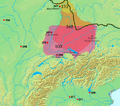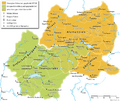Alamanni facts for kids
The Alamanni were a group of ancient Germanic tribes who lived in what is now parts of Germany, Switzerland, and France. They were known for living near the upper Main River, which flows into the mighty Rhine River. These tribes played an important role in the history of Europe, especially during the time of the Roman Empire.
Contents
Who Were the Alamanni?
The Alamanni were a collection of different Germanic tribes who came together. Their name, "Alamanni," might mean "all men" or "all people," suggesting they were a mix of various groups. They spoke a West Germanic language, which is related to modern German.
Where Did They Live?
The Alamanni originally settled in areas around the upper parts of the Main River. This region is in what is now southwestern Germany. Over time, they expanded their territory, moving into areas that are now parts of Switzerland and eastern France.
Their Land and Neighbors
- They lived near important rivers like the Main and the Rhine. These rivers were like ancient highways, used for travel and trade.
- Their lands were often forested, including areas near the Black Forest, which was known as Silva Marciana in ancient times.
- They were neighbors with the powerful Roman Empire for many centuries.
The Alamanni and the Roman Empire
The Alamanni often had a complex relationship with the Roman Empire. Sometimes they traded, but often they were in conflict.
Early Encounters
- The Romans built a long defensive wall called the Limes Germanicus to protect their borders from tribes like the Alamanni. This wall stretched across parts of Germany.
- Despite the Limes, the Alamanni frequently crossed into Roman territory, sometimes to raid and sometimes to settle.
Battles and Expansion
- From the 3rd century CE onwards, the Alamanni became more powerful and pushed further into Roman lands.
- They fought many battles against Roman armies. These conflicts were a big part of the history of the late Roman Empire.
- Their expansion led to them settling in areas like Alsace (in modern France) and parts of Switzerland.
Life in Alamannia
Life for the Alamanni involved farming, crafting, and warfare.
Daily Life and Culture
- They were skilled farmers, growing crops and raising animals.
- Archaeological finds, like belt buckles and weapons from graves, show they were also good at metalwork.
- Their culture had its own beliefs and rituals, as seen in some ancient artifacts.
The End of an Era
- By the late 5th century, the Western Roman Empire had fallen. The Alamanni had established their own kingdom in the region they called Alamannia.
- However, their independence didn't last forever. In the late 5th and early 6th centuries, they were defeated by another powerful Germanic group, the Franks.
- After their defeat, the Alamanni became part of the larger Frankish Empire.
The Legacy of the Alamanni
Even though the Alamanni lost their independence, their legacy lives on.
Language and Identity
- The Alemannic dialects of German, spoken today in parts of Germany, Switzerland, France, and Austria, are named after them.
- These dialects are a direct link to the language spoken by the ancient Alamanni.
- The name "Allemagne," which means Germany in French, also comes from the Alamanni.
Modern Connections
- The region where they lived is still known as Swabia in Germany, and their history is an important part of the heritage of this area.
- Their story helps us understand how different groups of people shaped the map of Europe long ago.
Images for kids
-
Alamannia is shown beyond Silva Marciana (the Black Forest) in the Tabula Peutingeriana. Suevia is indicated separately, further downstream of the Rhine, beyond Silva Vosagus.
-
The Limes Germanicus 83 to 260 CE.
-
The seventh-century Gutenstein scabbard, found near Sigmaringen, Baden-Württemberg, is a late testimony of pagan ritual in Alemannia, showing a warrior in ritual wolf costume, holding a ring-spatha.
See also
 In Spanish: Pueblo alamán para niños
In Spanish: Pueblo alamán para niños








